This post covers 101 inventions that changed the world in the last 100 years. It’s amazing what we can accomplish in a century. In just a period of 100 years, humans have seen, experienced, and witnessed plenty of changes in how we do things. With that said, here are 101 inventions that changed the world and improved the lives of billions of people all around the globe. Also, be sure to check out our top 100 inventors & 100 famous female inventors articles.
101 Inventions that changed the world
1. Aerosol spray can
The first patent for the aerosol spray can was granted in 1927 to a Norwegian engineer named Erik Rotheim. Despite the potential usefulness, it was largely undeveloped for no apparent reason (studies concerning the dangers of CFCs and Volatile Organic Compounds in aerosol cans started decades after the invention). The aerosol spray can was first put to good use in 1941 to deploy small amounts of pesticides by the American troops stationed in insect-infested areas. The cocktail inside the can was composed of sesame oil, pyrethrum, and Freon-12. Each can contained 16-ounces of bug bomb.
2. Quick-release ski binding
Extreme sports are called that for a reason. They have the potential to force you into an extremely dangerous situation that leads to injuries — a good example is skiing. Quick-release ski bindings were not considered a safety feature until 1937, when Hjalmar Hvam introduced a mechanism that allowed athletes to release the binding that secured their shoes to the boards in case of emergency. Applied with enough pressure, either by twisting the feet or positioning the feet at a certain angle relative to the board, the athlete would be able to release the board. He invented it while he was still recovering from surgery to treat his broken leg.
3. Super soaker
While certainly not the most important invention on this list, the Super Soaker (previously known as Power Drencher) debuted in 1989 and changed the way kids play. It immediately became a must-have for kids all around the country for two good reasons: the existing squirt guns were lame, and the Super Soaker was invented by NASA engineer Lonnie Johnson. By 1991, over two million Power Drenchers were sold.
4. Blender
The inventory is supposed to be associated with the invention, but that isn’t always the case. Take the blender for example. Stephen Poplawski invented it in 1922, but Fred Waring is the name most often accredited to the modern electric kitchen appliance. One main reason was that Waring — an orchestra leader — financially backed a tinkerer named Frederick Osius, who was developing a widget more or less similar to Poplawski’s blender. Waring wanted to use the equipment to make a cocktail of raw vegetables for his diet. Waring’s blender hit the market in 1937 and it cost $29.75. One million blenders were sold by 1954.

5. Bra
Caresse Crosby, in her teenage years living as a socialite in Manhattan, was the first to introduce a simple harness system for women’s breasts; something we now call a bra. However, the clothing article she invented was arguably too simplistic (or maybe even complex, depending on how you see it). She used a combination of a handkerchief and pink ribbon wrapped together fastened by a cord and called it a backless brassier. She did file the patent for it in 1914 but then sold it to Warner Bros. Corset Co. just a year later for a whopping $1,500. Crosby claimed that she did not expect the backless brassier to become widely popular.
6. Picnic cooler
Judging by its simplicity, you would think that a picnic cooler is one of those centuries-old inventions, but it isn’t. The patent for the picnic cooler was granted in 1953 to Richard Laramy, and later made popular by Coleman Company. Picnicking became a trend once again after the war as many Americans enjoyed prosperity and victory by relaxing on the lakes, woods, and beaches. A cooler, as the name suggests, has always been the perfect storage for cold drinks.
7. Digital video recorder
One thing that makes DVRs so popular is their (hidden) feature that allows viewers to skip commercials. In 2002, about a million DVRs were sold, which caused problems for TV advertising executives. About 40% of American households have DVRs sitting next to their TVs, but the concern that viewers are skipping commercials is not that serious. About 50% of DVR owners still watch commercials either out of laziness or because they’re unaware of the feature. For TV networks, the playback capability of DVR helps boost ratings by up to 10% or more.
8. Teflon pan
Polytetrafluoroethylene, or PTFE, was discovered by Roy Plunkett in 1938 at DuPont research laboratories. The research was meant to study CFC and some related gases, but in the lab, he accidentally froze and compressed tetrafluoroethylene (TFE). It became so slick that virtually nothing could stick to it. As it turned out, PTEE did not absorb substances from other materials it was exposed to either. DuPont called the new material Teflon and registered the trademark in 1945. Today, it is widely used in cooking utensils such as pans; manufacturers roughen a pan’s surface through sandblasting and apply Teflon to it.
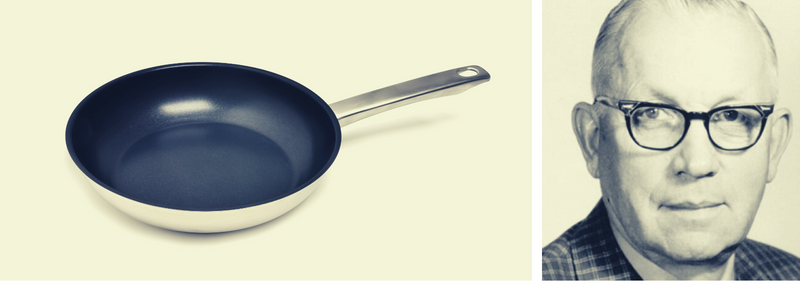
9. Zippo
Zippo made smoking even cooler than it already was in the early 1900s. The first Zippo came into existence in 1932 free from expectation that it would become a status symbol among smokers. The lighter went into mass production in January 1933 and the factory successfully manufactured 82 units during that first month. Not bad for a company run by three people: founder George Blaisdell and his two employees. Considering they only used simple equipment such as a used welding kit, kitchen hotplate, and a punch press, it was quite an achievement. Production capacity increased next month with 367 units being made. By 2012, more than 500 million Zippos have come out of its larger, more modern factory in Bradford, Pennsylvania.
10. Flash drive
The inventor of the flash drive, Fujio Masuoka, was supposed to work on DRAMs (Dynamic Random-Access Memory) for Toshiba but he came up with the concept of flash memory. The result was a flash drive with 8,192 bytes of data capacity. Along with Hisakazu Iizuka, he filed a patent for it in 1981. However, the memory required a way to connect to a computer. In 1996, Intel’s Ajay Bhatt and his Universal Serial Bus (USB) provided the solution. Although Toshiba was awarded a small bonus for the invention of the flash drive, it was Intel that made billions in sales on USBs and related technology. Fujio Masuoka’s invention was the groundwork on which flash memories with much larger capacities are now made.
11. Sunglasses
Although protective eyewear had been in existence since the 12th century, the first modern mass-produced sunglasses were introduced in 1929 by Sam Foster, ten years after he founded Foster Grant plastic company. At first, he focused on manufacturing hair accessories for women, but his decision to switch company direction turned out to be a good choice. The first pair of sunglasses was sold in Boardwalk, New Jersey and it only got better for Foster from there. By 1930, sunglasses could be found in literally every store in the U.S. As his business was rapidly growing, he adopted a manufacturing technique called injection molding, which revolutionized plastic production in the country.
RELATED: Cad Crowd is a place for inventors to find designers ready to turn their ideas into 3D models.
12. Drip coffeemaker
Traditional percolators had dominated the coffee-making industry for over a century before the drip coffeemaker came onto the scene. The first patent for the electric drip coffeemaker was granted to Gottlob Widmann of Germany in 1954. Drip coffeemakers became popular in the United States thanks to Mr. Coffee, a subsidiary of Newell Brands. The way the machine works is almost similar to that of the percolator, but the process is more simplified. Around 14 million drip coffeemakers are sold in the U.S. each year.
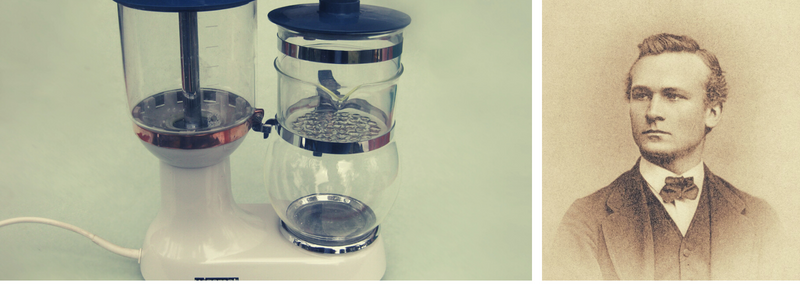
13. Pop up toaster
Toasting bread is one of the most traditional things that we still do on a daily basis. For many thousands of years, the job was simply done by putting slices of bread on top of a heating element, like an open flame. Charles Strite was the man to first introduce the electric toaster to the world — not just a toaster either, but a pop-up one that would spring release the bread when it was done. Mainly intended for restaurant usage, the appliance became so popular that 12 million units are sold each year to American homes. In fact, pop-up toasters are in 90% of American households today.
14. Leaf blower
The leaf blower (or just blower) was meant to be used as a tool to disperse chemicals onto crops. It was not clear who invented it for that purpose, but Aldo Vandermolen came up with the idea to wear it with a harness and called it a backpack leaf blower. In California, where water was (and still is) scarce, a backpack leaf blower was considered the more economical way to get rid of leaves, compared to using water to wash them away. However, the air pollution and loud noise became a serious concern. At least 20 cities in the state have banned the use of the leaf blower; 80 more cities are considering the implementation of the same regulation.
15. Spincast fishing reel
Zero Hour Bomb Company (ZEBCO) was on the brink of extinction in 1949 until R.D. Hull presented the company with a plan to make a user-friendly enclosed backlash-free fishing reel. Together with Denison-Johnson Reel Company, ZEBCO introduced the first commercial spin cast reel and ended up selling thousands of units. The company is still in business and going strong today.
16. DVD player
The entertainment industry has gone from black and white to VHS all the way to Blu-ray today, and who knows what the technology will come up with next. A prototype of the DVD player was developed in 1994 by, once again, Toshiba. It was a sophisticated and rather messy pile of circuit boards nicknamed Fire Tower; the second prototype was much tidier called Vanguard. Regardless of its neatness, the prototype was proof that DVDs audio/video quality put VHS to shame. They came out for sale in 1996 and it only took one year until the first feature film was put on DVD and released.
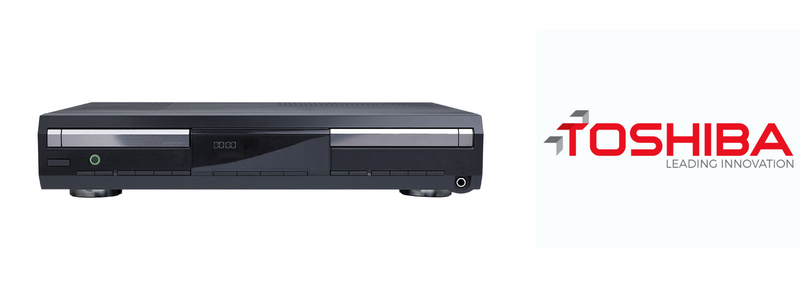
17. Chainsaw
The first chainsaw model appeared in a publication called “Principles of Midwifery, or Puerperal Medicine” by John Aitken in 1785, but it was not what you think it was. When you hear the term chainsaw, the first thing that comes to mind is the tree-cutting machine. That chainsaw was designed to remove diseased bone. Until 1949, almost all chainsaws were bulky and operated by at least two pairs of good muscular hands. McCulloch Motors Corp. introduced a portable, lightweight chainsaw in 1949 so that anybody could be a menacing warrior in the backyard, cutting firewood and pruning small trees.
18. Electric razor
There were several individuals credited with developing the electric razor we all know today. One of them was John F. O’Rouke who filed the first patent for an electrically-powered razor in 1898. Others slowly followed suit, including Prof. Alexandre Horowitz of Philips, who also filed a patent for a similar grooming tool in 1930. The first electric shaver was made by Remington Rand Corporation in 1937. The rotary shaving head was the brainchild of Prof. Alexandre Horowitz of Philips, and it allowed the razor to cut at skin level. Modern versions with built-in rechargeable batteries began to appear in the 1960s. Many of them are now waterproof as well.
19. Printer
Similar to many computer-related technologies and peripherals, the laser printer we know today is a result of continuous innovation by multiple entities. The original laser printer was developed at Xerox PARC (Palo Alto Research Center) between 1969 and 1971. Using the research as the groundwork for a new model, Xerox released the “9700 Electronic Printing System” just six years later. It compiled all the good things possibly packed in a printer including page formatting, character generation, and laser scanning.
Before Xerox put the 9700 on sale, in 1976, IBM had started making an industrial-grade laser printer with the capability of operating at 100 impressions-per-minute. In fact, IBM claimed that the first one was installed in an accounting office in that same year, so it actually was a step ahead of Xerox. Also according to IBM, it was the first printer to utilize laser technology and electrophotography at the same time.
Hewlett-Packard made a breakthrough in 1988, not with laser printer but with its DeskJet inkjet printer. Because the company was able to manufacture it at a relatively low production cost, it became a viable home computer peripheral. Still, it came with a $1,000 price tag. Now you can buy an HP DeskJet for $40 or less.
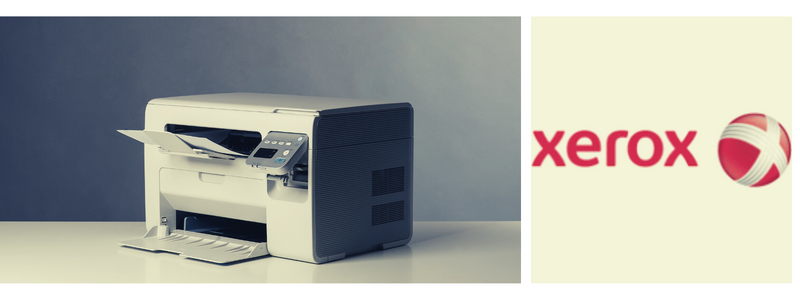
20. Stopwatch
Stopwatches were invented in the last 100 years, but early models could only measure with accuracy down to roughly between 1/5th and 1/10th of a second. In the real world, that should be precise enough, but watch-makers are known to want more. In 1916, TAG Heuer shook the work with its accurate 1/100th of a second stopwatch called the Mikrograph. It was so accurate that TAG Heuer was appointed the official timekeeper in three Olympic Games (1920, 1924, and 1928). Digital stopwatches with the ability to measure down to 1/1000th of a second accuracy made a debut in 1971, invented by Cox Electronic Systems.
21. Kodak carousel
While the Kodak Carousel was not the first projector to utilize 35mm slides, it was the first user-friendly one. Prior to the invention of the device in 1961, projectors mostly relied on mechanical parts to move the slides in sequence in front of the light source. At that time, the horizontal feed system was common. Kodak found out that the most dependable slide delivery system was a force of nature known as gravity. Instead of using the common horizontal-feed system, Kodak mounted the slides in a vertically mounted locking ring. As it rotated thanks to gravity, every slide released itself in perfect sequence with almost zero chance of jamming. Kodak Carousel proved that a mechanically simpler device could work better than a more complicated one.
RELATED: We offer invention help for every field, including game design and automotive design.
22. Boombox
First introduced by Philips of Netherlands around 1966–1969. The intention was to allow the audience to record radio broadcasts to a cassette with a single device. Other European brands also developed similar things including Grundig of German. The original boombox was so popular in Japan that a lot of different companies followed suit by developing the same thing. Soon enough, Japanese-made boomboxes took over the European market. In the United States, the boombox started to gain popularity in the mid-1970s and was made by popular brands such as Panasonic, General Electric, Sony, and Marantz. The CD player eventually caught up and was included as a feature in many units beginning in the 1980s.
23. Electric toothbrush
Broxodent, the first electric toothbrush invented by Dr. Philippe Guy Woog in 1954 for Broxo S.A. was designed for orthodontic patients and people with limited motor skills. It was not powered by a battery but had to be plugged into an electrical outlet to use. E. R. Squibb and Sons Pharmaceuticals introduced Broxodent electric toothbrush in the U.S. in 1960. The first USA-made electric toothbrush was General Electrics, which came to market in 1961. It also improved upon earlier models.
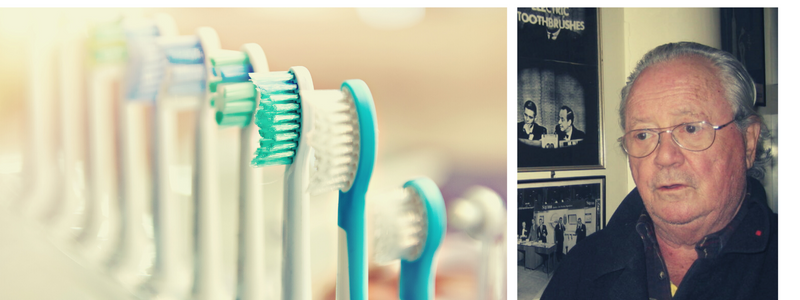
24. Binoculars
Another example of a traditional device that became popular and accessible to the public thanks to modernization is binoculars. Until 1941, binoculars were mainly specialty equipment, handmade, and expensive. Even the lenses had to be imported from Germany. When the United States entered World War II, developing a method to quickly and affordably produce large numbers of binoculars suddenly became a priority. Thanks to the Universal Film Company, which reconfigured its film manufacturing process, binoculars didn’t have to be expensive to be effective. When the war ended, binoculars contributed to a new kind of hobby: bird-watching.
25. Lunchbox
According to a publication in Smithsonian Magazine, the original lunchboxes (various shapes of tin cans) came around in the 1880s. Despite its importance in the everyday life of the American worker and school children, there was no mass production until 1902. It actually took lunchboxes about 50 years before it gained popularity. The lunchboxes we’re familiar with — tin boxes with printed characters — were based on Aladdin Industries’ Hopalong Cassidy lunchbox launched in 1954. More than 550,000 units were sold in the first year alone. Over the course of 20 years (1950–1970), over 220 million lunchboxes flew off store shelves.
26. Zipper
While the first generation of zipper called the “clasp-locker” was invented in 1893 by Whitcomb L. Judson, the modern iteration of the zipper we all know, use, and are familiar with today was developed in 1913. It was slow to catch up with the world and only about 24,000 of them were sold in the first four years. When Esquire magazine praised the modern zipper as a tailoring idea for men in the 1950s, the small clothing fastener took off immediately. Japan-based YKK is one of the biggest zipper manufacturers today, producing more than seven billion units each year.
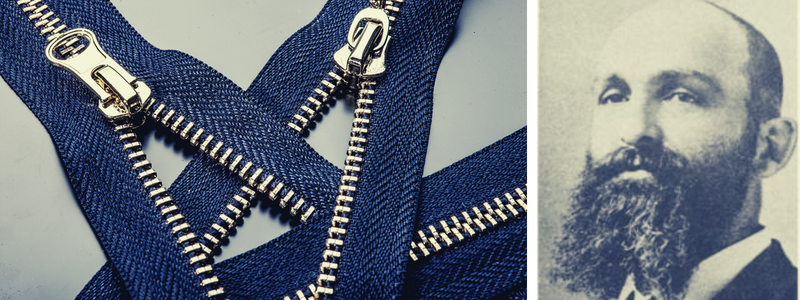
27. Kettle grill
The Weber Kettle Grill, a small yet genius invention by George Stephen, is to thank for the traditional BBQ. Weber-Stephen Products Co. is the company that is best known for manufacturing the charcoal grill. A co-founder of the company, George A. Stephen, Sr. deserves to be credited with the invention of a more modern version of the charcoal kettle grill. It was said that he found no pleasure in grilling since his old dependable yet somehow irritating brazier pit always produced enough smoke to annoy the neighborhood. So, he took a metal buoy, cut it in half, and made a rounded lid — a dome-shaped charcoal grill with some vents to release small amounts of smoke was born. He did that in 1951, and a year later his company began selling it.
28. Smoke detector
The patent for the fire alarm was granted to Francis Robbins Upton 1890, while the electrical heat detector was patented by George Andrew Darby in 1902. In 1951, large and costly smoke detectors were first sold in the United States, but they were viable options only in commercial and industrial facilities due to the high price tag. Small battery-powered smoke detectors for the household was invented by Duane Pearsall, the founder of Statitrol Corporation, in 1965.
He accidentally realized the invention after one of his coworkers smoked directly into the fan of a generator in a room used to measure ion concentration. When the exhaled smoke entered the inlet, one of the technicians saw that the ion concentration indicator flat-lined. Although Pearsall’s intention when he founded the company was not to save lives, that’s exactly what he did.
29. Moog synthesizer
The voltage-controlled analog synthesizer was first introduced by Robert Moog in 1964, but he asked for $15,000 per unit. As a result, the device did not catch up quick enough with the world. So, he sent his sales team to demonstrate what the device could do at the Monterey Pop Festival — suddenly, it became a must-have for anyone in the music industry. It is safe to say that the Beatles and Simon & Garfunkel would have sounded differently without a Moog Synthesizer.
30. CD-ROM
It sounds like a simple invention, but you’d realize how the CD made life so much easier if you ever had to deal with floppy disks. It was invented in 1966 by James T. Russel. However, the CD-ROM format with the ability to store any form of digital data was developed by Denon in 1982. A CD has much bigger storage capacity and is easier to handle than a floppy disk.
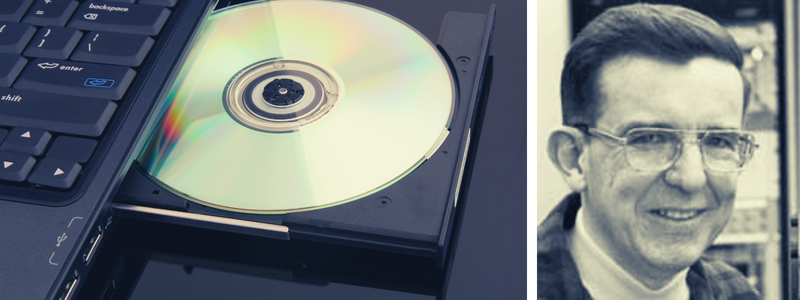
31. Hair dryer
The predecessor to the hair dryer has been around since 1890, starting in France. Back then, it was called a blow dryer because you would use it to apply heat to anything other than just hair. There are many similarities and differences between the blow dryer and hair dryer, but it is obvious that the latter is designed specifically for hair-styling purposes. Early models were bulky and hard to operate. Hamilton Beach was one of the companies that contributed to the invention of the portable hair dryer in the 1920s. The company’s engineers came across it when they tried to make a device to blow heated air into milkshakes.
32. Tape recorder
Modern tape recording as we know it today was initially developed in Germany during the 1930s by the collaboration of IG Farben, AEG, and state radio RRG. It was all based on oxide-powder lacquered paper tape invented by Fritz Pfleumer in 1928. Until after World War II, most Americans never thought of how useful tape recording could be. Jack Mullin of the U.S. Army’s Signal Corps brought two German recordings back home in 1945 and the craze started.
33. CB radio
The Citizens Band (CB) radio began in 1945, but it took a while until Americans became aware of its true potential. Truck drivers actually played a major role in popularizing CB radio when they organized a convoy to scout the locations of speed traps; at that time, there was a nationwide 55mph speed limit. By 1974, around a million Americans own CB radio licenses and in just three years afterward, there were at least 20 million CB radios in operation.
34. Ballpoint pen
While writing and calligraphy have been in existence since ancient times, the ballpoint pen is relatively new. America’s first ballpoint pen, the Reynolds Rocket, went on sale at Gimbels in October 1945; a unit cost about $12.50 or the equivalent of $170 in 2017 dollars. There had been multiple attempts by many people to create a reliable ballpoint pen long before Milton Reynolds did it. A lot of the previous designs were actually good enough, but the Reynolds Rocket was the first to gain commercial success. As more companies started to offer similar products, market competition forced the price to drop significantly in the subsequent years.
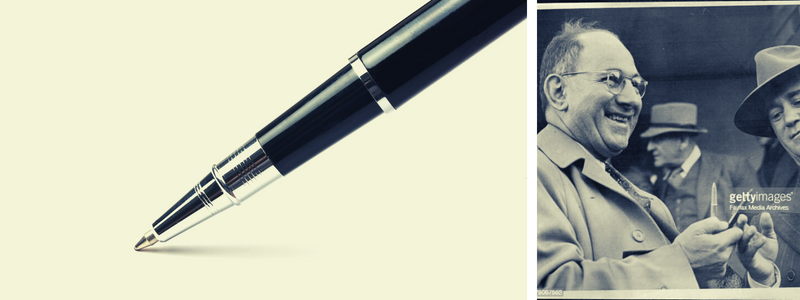
35. Kindle e-reader
Starting its venture as an online bookstore, Amazon has come a long way. It is now in the digital innovation industry and has proven its power to the world with various popular products; one of them is the Kindle E-Reader. A key feature in the e-reader is the built-in wireless internet that allows users to access millions of books available online. The Kindle changed the book-reading paradigm, but Amazon did not invent it. Some models came earlier including the SoftBook and Rocket eBook in 1998.
36. Cassette tape
Preceded by tape recording, the actual modern cassette tape was an invention of Philips in 1962. It stayed popular until the CD came along. The cassette tape declined as people turned to digital audio.
37. Circular saw
The spinning blades in a sawmill were too big to be used as home woodworking equipment, which encouraged Edmond Michel to make a new portable design that could imitate the wood-cutting process in the mill. In 1923, he came up with a more simplified form of the modern circular saw. It had no electric circuit, so an external generator was required to operate it. When creating the equipment, Michel also invented the worm-drive motor.
38. Game boy
Gaming seems to be part of everyday life in the modern smartphone-connected world, and we sometimes take it for granted. When the original Nintendo Game Boy hit the market in 1989, it was so popular and groundbreaking — the name Nintendo became synonymous with the term video game. Today, it’s still one of the most successful game consoles ever released.
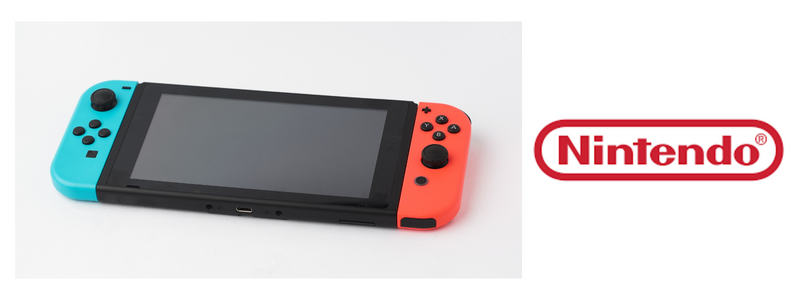
39. Sony walkman
The popularity of cassette tapes helped the sales of the Sony Walkman (or the other way around). Introduced in Japan for the first time in 1979, Sony actually sold out the first batch — 30,000 units — in just eight weeks. A year later, the Sony Walkman landed on American soil and worldwide admiration began. By the end of its production line in 2010, Sony had sold more than 220 million Walkman units.
40. Floppy disk
IBM introduced the floppy disk in 1971, and afterward, it continued to evolve from an eight-inch large size to the last favorable form factor at just 3.5 square-inches. While the actual floppy disk has lost its reputation (except perhaps as a coaster) with the rapid development of portable hard drives and CDs/DVDs, its legacy has not completely vanished. Both “save” and “save as” options in Microsoft Office Suite software still use the floppy disk icons.
41. Polaroid camera
Edwin Land granted the wish that his daughter made in 1943; she wanted to see the photographs her father captured instantly. It took Land just four good years to make it happen. The Land camera was manufactured by Polaroid between 1947 and 1983; it went on sale for the first time in 1948. Not only did he grant his daughter’s wish, but he also made millions over the following decades.
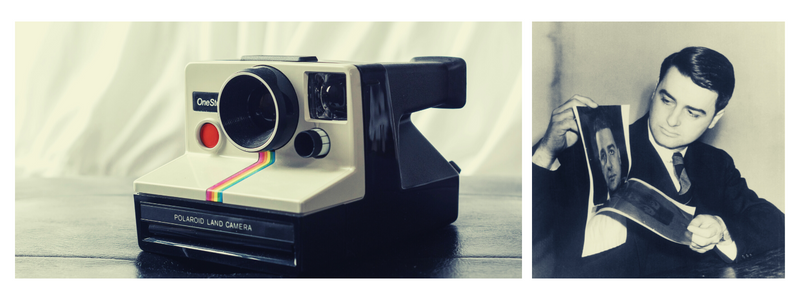
42. MP3 player
The portable digital audio player did not start with the iPod, but with something called IXI — an innovation introduced by a British scientist Kane Kramer in 1979. He filed a patent in 1981 but failed to renew it in 1985 due to financial issues. In 2008, Apple acknowledged Kramer as the inventor of the digital audio player. Regardless of the dispute between who invented what, the iPod — just like the Kindle — changed the game. Its compatibility with the iTunes music store makes it easier for users to buy and listen to new songs on the go.
43. Pocket calculator
Japan-based Casio made the first all-electric calculator called the 14-A, but it was made to be installed to a desk. Pocket calculators appeared for the first time in Japan, including the Sharp QT-8B, Sanyo Mini Calculator, and Canon Pocketronic. Developments continue to this day and you can purchase a small device that counts billions of decimal points for just a few dollars.
44. Wi-Fi router
ALOHAnet successfully connected the Hawaiian island with the use of the UHF packet network. It was probably the real first Wi-Fi architecture in use. The first version of the 802.11 protocol came to scene in 1997. Today, Wi-Fi is integrated into more than 9,000 devices including phones, TVs, laptops, and even wristwatches.
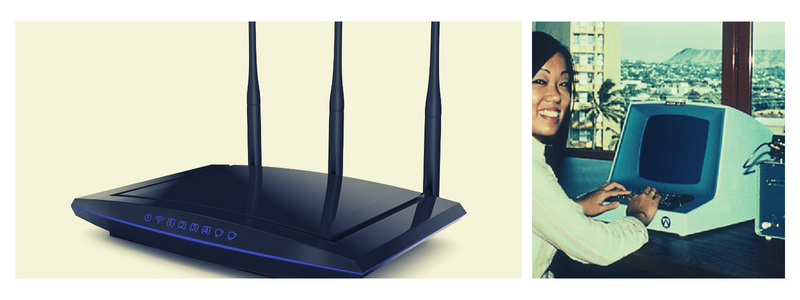
45. Digital HDTV
MUSE, or Multiple sub-Nyquist Sampling Encoding, was put to good use in Japan in the late 1980s. Japan also started the earliest HDTV system called Hi-Vision (high definition television), and the effort to make it happen began in 1979. The United States saw the demonstration of MUSE by Japanese engineers in 1987 and the first HDTV went on sale in 1998.
46. Digital wristwatch
The first digital electronic watch was developed by Hamilton Watch Company and Electro-Data. Pulsar, which was then a division of Hamilton Watch, wanted to make a futuristic timepiece based on the fictional one made by Hamilton for 2001: A Space Odyssey. The result was an 18-carat gold wristwatch with an LED display. It was also the first Pulsar watch. Unveiled in 1972, the price tag was $2100 — $12,700 when you account for inflation.
47. Electric can opener
Small things tend to make life easier — case in point, the electric can opener. First, it was developed and patented by Preston West in 1931 based on the cutting-wheel mechanism. Although advertised as being capable of removing lids from as many as 20 cans in just a minute, this model failed to gain public attention. After being dormant for about 25 years, the electric can opener was reintroduced by Klassen Enterprises in 1956, yet this one dealt with the same fate as the predecessor. In the same year, Walter Hess Bodle combined the can opener and knife sharpener into a single electric-powered device. The device was manufactured under the “Udico” brand and gained immediate success, partly because it was unveiled for a Christmas sale.
48. Cordless drill
The first line of home power tools was developed by Black + Decker including drills and related accessories. Then in 1961, the company released the first cordless power drill powered by rechargeable nickel-cadmium battery. From that point forward, the cordless power tools market was flooded with innovations from various brands such as Milwaukee, Bosch, and Makita. Good changes happened — for example, more voltage, user-friendly chuck design, and of course, the use of a lithium-ion battery.
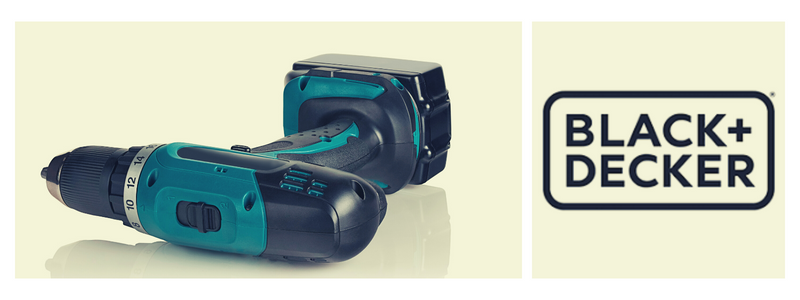
Need help figuring out how to get a patent? We can help with that too.
49. Microphone
While it is true that the microphone was developed in the 19th century for use in the telephone, nobody realized that they could use it to help singers sound louder and clearer. The beginning of the 1920s saw microphones migrate from phones to recording studios and nightclubs. Of course, the design and electric circuitry had become much better at that point. In addition to the benefits of making the singer’s voice louder, microphones also improved how musical instruments sounded; all in all, people were able to listen to better music thanks to the microphone. From 1926 to 1930, microphones improved at a rapid speed.
50. Digital camera
The idea of the filmless camera started in 1961 for use during space exploration to mark astronauts’ positions based on images of planets and stars that they could capture while traveling through space. It was proposed by Jet Propulsion Laboratory’s Eugene F. Lally. In 1972, an employee of Texas Instruments, Willis Adcock, also filed a patent for a filmless camera. Both ideas did not make it to the public. Another attempt was the Fuji DS-1P developed in 1988, but it was never sold. The first successful model to hit the market was the Dycam Model 1, more commonly known as the Logitech Fotoman in 1990. Kodak eventually ended its Kodachrome film format 19 years later.
51. Microwave oven
An engineer of Raytheon Corporation, Percy LeBaron Spencer, accidentally discovered the cooking power of magnetron while he was experimenting with vacuum tubes for radar systems. It is believed that he realized the breakthrough from the melted candy bar in his pocket. He continued experimenting with the magnetron and figured out he could make popcorn with it. He nicknamed the invention Speedy Weenie. The first countertop microwave oven hit the market in 1967.
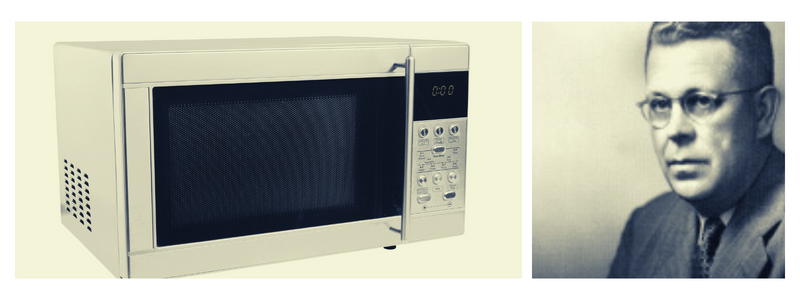
52. Computer mouse
The computer mouse made its way to the world thanks to researchers in the Royal Canadian Navy in 1952. It was not as small as a mouse; a capybara would be a more accurate nickname. The trackball used was made out of a duckpin bowling ball. Credit for the invention of the computer mouse is given to Douglas C. Engelbart, partly because the form factor became the groundwork of any modern computer mouse. It was not until Apple paired a mouse with the Lisa computer that it grew to become a rudimentary peripheral.
53. LED
Oleg Vladimirovich Losev invented the LED in 1927, but no one except himself could find any good use for it. He filed a patent for his invention and called it Light Relay. General Electric’s Nick Holonyak is credited with the invention of practical visible-spectrum LED in 1962. From there onward, LED efficiency has been improving.
54. CD Player
Although the CD was invented in 1966, the first CD player wasn’t released to the market until 1982 and it cost more than $1,000 per unit. Despite the high price tag, over 400,000 players were sold between 1983 and 1984. Sony and Philips made the effort to standardize the format in 1979, allowing anyone to purchase any CD or player from any company without compatibility issues.
55. Camcorder
Originally designed for television broadcasting, the first video cameras were heavy and supposed to be mounted on special supports. In 1983, Sony’s Betacam system was released and intended for professional use. Sony also released the Betamovie BMC-100P in the same year, which was consumer-grade and used Betamax cassette. It was still bulky, so users needed to mount the equipment on their shoulder for steadier recording. A less bulky home camcorder was released by JVC. During the early 1990s, Americans took pleasure in recording and watching home videos — America’s Funniest Home Videos became number the one series on tv thanks to this.

56. Electric guitar
It seems like everybody wanted to be credited as the inventor of the electric guitar, but it’s still unclear who actually made it first. However, the first true electrically amplified guitar was designed by two people: George Beauchamp and Paul Warth, the general manager and vice president of National Guitar Corporation, respectively. Leo Fender designed the first mass-produced electric guitar called the Fender Telecaster. He wanted to call it the Broadcaster, but that would have been a copyright infringement. Today, it remains in production with many variations and modifications. Leo Fender, a pioneer in electric guitar, didn’t play guitar; legend has it that he didn’t even know how to tune the instrument.
57. Pager
The telephone pager system was first patented by Alfred J. Gross in 1949. The typical phone did not have a keyboard back then, so pagers were the only “portable method” to send a digital text to someone. Nikola Tesla actually predicted this way back in 1909 when he said that soon enough, people would be able to transmit wireless messages. Of course, texting became a true phenomenon in the age of the BlackBerry. The Inter@ctive Pager was introduced by BlackBerry (then RIM) in 1996. The device allowed users to utilize the wireless data network to send and receive text messages. Nowadays, even kids can tell the whole world about their every thought by tweeting.
58. Mobile phone/smartphone
Development in wireless communication technology has progressed a lot since the pager. Martin Copper, researcher and executive at Motorola, invented the portable handheld phone in 1973. Martin Cooper’s invention became the groundwork for further development that led us to the smartphone. It took the company a whole decade before the DynaTAC 8000x hit store shelves. DynaTAC stands for Dynamic Adaptive Total Area Coverage. Manufactured from 1983 to 1994, a single unit cost nearly $4,000 (or the equivalent of around $9,500 in 2017) during its first year.
While Motorola deserved the credit for the innovation, the first true smartphone came out of IBM. It was called the Simon Personal Communicator — people didn’t start using the term “smartphone” until 1995, but Simon actually made its debut in 1992, about 15 years before Apple launched its first iPhone. IBM’s Simon was equipped with enough features to do many things, like sending and receiving faxes, emails, and cellular pages in addition to making phone calls.
It even had apps, like a calendar, calculator, notepad, predictive keyboards, world time clock, address book, appointment scheduler, and handwritten annotations. IBM Simon was a capable device, even by today’s standards. It even had an LCD touchscreen, albeit a monochrome one. The price was $899 at launch with a service contract (more than $1,500 today). Nowadays, smartphones are the most widely used gadgets all around the world. Even an affordable one comes equipped with a camera, GPS, multimedia player, and Internet connectivity.
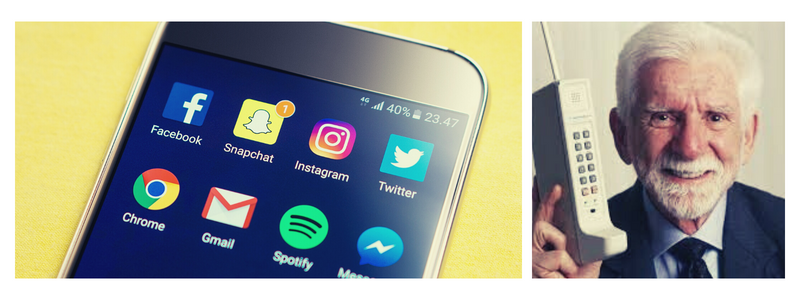
RELATED: Check out this list of the 11 most successful Shark Tank products!
59. Hi-Fi
Sidney Harman and Bernard Kardon, the general manager and chief engineer at David Bogen Company, respectively, resigned from the company due to management changes. With an investment of $5,000 each, they founded the Harman Kardon Company in 1953 and made the first integrated hi-fi receiver (with tuner, power amplifier, and pre-amplifier) called the Festival D1000. The whole hi-fi craze became apparent in the 1950s, during which the average John could get a budget-friendly and high-quality audio player.
60. Sewing machine
Mechanical stitching machine dates back several centuries, but a true portable sewing machine appeared for the first time in 1993 at Chicago World’s Fair. The Featherweight made by Singer Manufacturing Company only weighed 11 pounds thanks to its small size and aluminum construction. It stayed in production for 35 years. From 1933 – 1968, more than three million units were sold.
61. Laptop
After the personal computer came to the scene in 1971, the idea of a portable personal computer inevitably followed. One of the first laptops (or something similar to that) made commercially available was IBM 5100, unveiled in 1975 and equipped with just a five-inch CRT display. However, the GRiD Compass 101 truly set the foundation for future laptops with the iconic clamshell design, a display with 320×240 pixel resolution, a 1,200 bit/s modem, and Intel 8086 processor. It was also compatible with a floppy drive and hard drive by using an external connection. Released in 1982, it was used by the U.S. Military and NASA.
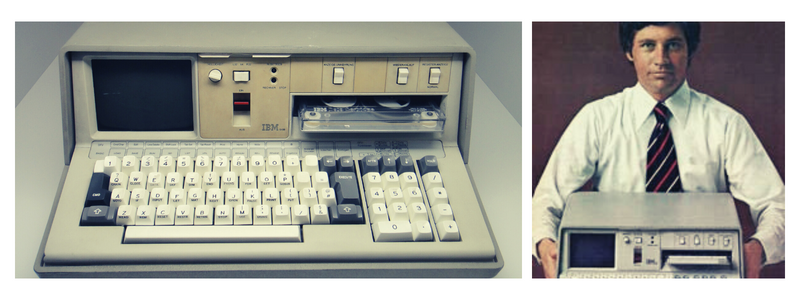
62. VCR
Videocassette recorders and video tape recorders are different things, although the former was based on the latter. Philips developed the VCR format in 1970 specifically for tv stations but it was made available to consumers just two years later. Philips called it Video Cassette Recording and people referred to it as “the N1500” (the first model of the device). VCRs gained mass popularity in 1975, and by that time, six major names contributed to the development including JVC, RCA, Sony, Matsushita Electric (Panasonic), Toshiba, and AMPEX. Among the products made by those companies, the Japanese devices manufactured by Sony, JVC, and Matsushita Electric dominated the market. In 1982, the president of the Motion Pictures of America, Jack Valenti, thought that such devices were no more than savagery for the film industry. But the Supreme Court eventually approved VCRs for home recording purpose in 1984.
63. Answering machine
PhoneMate Model 400 was the first answering machine made commercially available. It could record and play up to 20 messages. The machine required a separate accessory in case users wanted to listen to their messages with a little more privacy. This device was also quite big, at 10 lbs, partly because it was enclosed in a wooden box.
64. TV remote control
Radio-controlling has been around since the late 1890s. Nikola Tesla actually filed a patent for the technology and called it “Method of an Apparatus for Controlling Mechanism of Moving Vehicle or Vehicles.” The first tv remote control was an invention of Zenith, but it still had to connect to a television set by wire. The device was nicknamed Lazy Bones, and rightly so. Wireless remote controls were developed five years after by Eugene Polley.
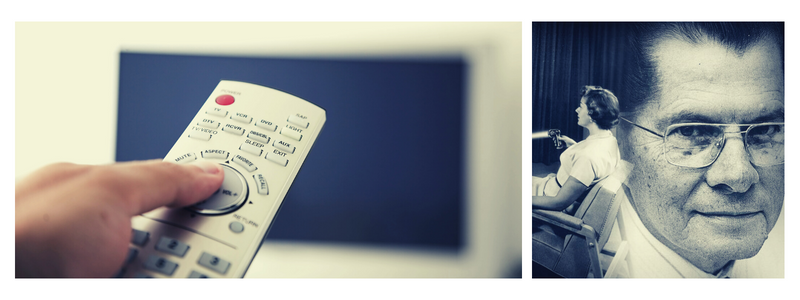
65. Handheld GPS
Long before GPS became widely available and affordable, it was the actual navigation system used by the U.S. military. Only after the Soviets shot down a Korean airliner flying in a no-fly zone, the U.S. government opened the technology and allowed the public to use it, albeit with some accuracy limitations. The first handheld GPS commercially available was made by Magellan and sold in 1989.
66. Transistor radio
Following the invention of the transistor in 1947 at Bell Laboratory, the transistor radio soon became available and favorable over the previous vacuum-tubes models. The Regency TR-1 hit store shelves in 1954, and more than 100,000 units were sold despite its mediocre performance. Over the course of just a decade, between the 1960s and 1970s, billions of transistor radios were manufactured. This made it the most widely used electronic communication device in human history.
67. Modem
The name does explain a little bit about how it works: Modulation and Demodulation. The U.S. Air Force was among the first to take advantage of the modem by implementing the mechanism into radar systems in 1949. Data captured by radar was converted into sounds and delivered through phone lines. At the other end, the sounds were converted back into data. The transmission was still overwhelmingly slow for any other data transmission process. Even after 40 years, after the modem-based radar technology, the transmission rate was still only 56 kbps — barely enough to open an email.

68. Portable Air Conditioner
Air conditioning systems in prehistoric time relied on the force of nature. People gathered ice and snow during winter and stored them for use in the hot summer. Mechanical ice-making machines replaced that primitive idea, and then it was replaced again with electric air conditioning. After its first introduction in 1939 by Willis Carrier at New York World’s Fair, about a million units were sold.
69. Personal computer
Early personal computers were sold as kits. The Altair 8800 was released in January 1975 by MITS, a relatively small company that focused on making electronic kits for enthusiasts. While the target consumer was not the general public, MITS received thousands of orders in the first month of production. When IBM introduced the 5150, commonly known simply as the “IBM PC” in 1981, home computers slowly began to gain acceptance as personal equipment.
70. Television
Many people were involved in the development of television. Even Alexander Graham Bell and Thomas Edison theorized about transmitting images and sounds at the same time. Since the demonstration of modern television in 1939 at the New York World’s Fair, the world changed. This technology allowed people to witness historical moments. By the end of 1949, only about a million Americans owned a television. However. the number skyrocketed four years later to roughly 25 million. Today, it’s safe to say that 99% of American homes have a TV. Philo Farnsworth completed the first full all-electronic television on September 7, 1927, and filed a patent for the system that same year.
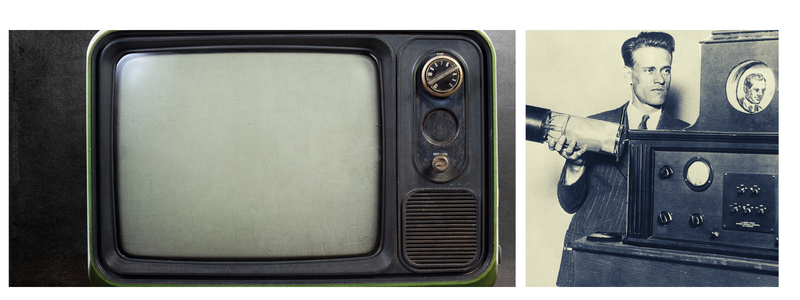
71. Modern Lie Detectors
Early models of lie detectors utilized torture. Some believe it all started during the Middle Ages when investigators used boiled water to tell if someone was lying. The consensus was that an honest person could withstand the heat better. Lie detectors have been around since the late 19th century, but it was William Moulton Marston who came up with a machine that (arguably) accurately indicated a strong correlation between lying and systolic blood pressure. He published his work in 1918. Marston credited himself as the “father of the Polygraph.”
RELATED: Our product design services can help you turn your idea into a ready-to-ship product!
72. Self-winding mechanical watch
The hardwood system was the first known self-winding mechanical watch unveiled in 1923, but the mechanism was too complicated, and the mainspring could only make 180-degree movements. Rolex improved the idea in 1931 by using a unidirectional rotor. The Eterna Watch, however, was the first reliable self-winding mechanical watch thanks to the use of heftier rotors and jewel bearings. The rotor itself was different from the one suggested by Rolex. Eterna came up with a small piece of engineering called the “ball bearing” as the rotor.
73. Electric kettle
The idea of the kettle-shaped vessel is nothing new. In fact, it’s been in existence for thousands of years. One of the earliest kettles was discovered in Mesopotamia. Of course, it was bronze and decorative. Fast forward several years, and we get the first electric kettle manufactured by the Carpenter Electric Company. Unveiled in 1891, the design was influenced by R.E.B. Crompton. This was not the electric kettle we know today, as it had an external heating element. In 1992, another improvement came from the Swan Company, which used a built-in heating element possibly submerged in water. It could still boil water dry because there was no automatic switch to turn the kettle off when the water reached boiling temperature. Russell Hobbs Company used the first automatic switch-off feature.
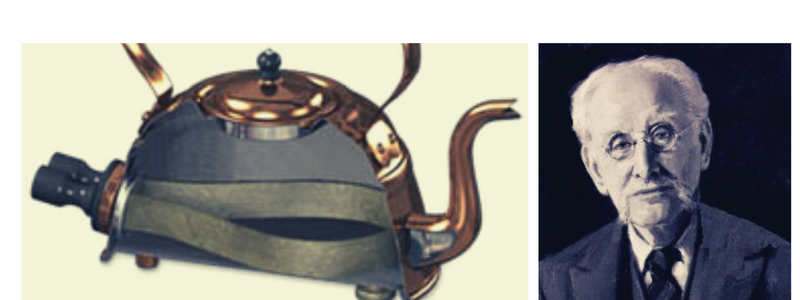
74. Jet engine
The Aeolipile was the first known jet engine and it was invented around 150 B.C. But it was far from useful enough to power a plane. Two men deserved credit for the invention of the practical jet engine: Hans von Ohain and Sir Frank Whittle, although they worked separately and were unlikely aware of each other’s doings. Hans von Ohain actually built the first jet engine mounted on a plane and made a successful flight on August 27, 1939. Frank Whittle patented his turbo engine in 1930, although he didn’t perform a flight test until two years after Ohain had.
75. Helicopter
Leonardo da Vinci probably drew something that looked like a helicopter, but it was just a drawing. After a long period of development, Igor Sikorsky made a series of successful flight tests on his VS-300 between 1939 and 1941. Albeit relatively simple and powered only by a 65-horsepower engine, the vast majority of modern helicopters use the same features Sikorsky utilized, such as a three-bladed main rotor and a tail rotor.
76. Artificial heart
Like many medical devices, the first artificial heart was planted into an animal. Vladimir Demikhov made a successful attempt at implanting an artificial heart into a dog in 1937. Implanting it into a human is a different story, and Dr. Robert Jarvik is credited with inventing the permanent artificial heart that actually worked. The first surgical procedure to implant an artificial heart was performed by Dr. Willem Kollf in 1982 on a patient named Barney Clark.

77. Kidney dialysis machine
The doctor who performed the first successful surgical procedure to implant an artificial heart into a human, Dr. Willem Kollf, also invented the kidney dialysis machine. The first few models were ineffective, but he continued improving the machine and saved many lives. Major improvements came along in 1960 when Dr. Belding Scribner invented the Teflon shunt that could be permanently implanted into patients’ arms. Scribner’s shunts prevent patients’ blood from clotting during dialysis.
78. Food mixer
Herbert Johnson of Hobart Manufacturing Company took credit as the inventor of the food mixer in 1908. However, the first models were intended only for large bakeries and food factories. Hobart introduced a smaller version of the food mixer (Kitchen Aid Food Preparer) for home use in 1919.
79. Alkaline battery
Three people filed the patent for the alkaline battery in 1957: Lewis Urry, Karl Kordesch, and P.A. Marsal. The patent was granted in 1960 and assigned to the Union Carbide Corporation. A new type of battery was introduced in the late 1960s, and back then, it still contained some potentially toxic mercury. During the years that followed, new regulations came along to limit the use of heavy metals.
80. Power steering
Although the first power steering used in an automobile was installed in 1876, a true practical system did not appear until 1926. Francis W. Davis, an engineer for the truck division of Pierce-Arrow, started the development and came up with the idea. He then moved to General Motors to propose the idea but was rejected out of fear of increased production costs. After the rejection, Davis signed up with Bendix, an automobile parts manufacturer. Military need during World War II for a system that assisted steering for heavy vehicles increased the demand for power steering. Finally, in 1951, Chrysler was the first to introduce a commercially available vehicle equipped with power steering, the Hydraguide.
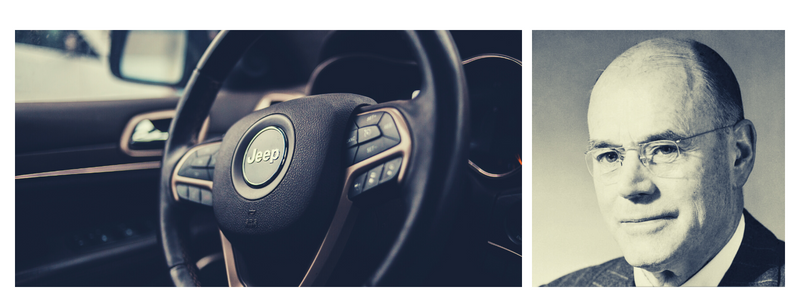
81. Flight recorder
Type HB was one of the earliest, yet very effective models of flight recorders invented in 1939 by Paul Beaudouin and Francois Hussenot. It was a photograph-based flight recorder captured on 88mm wide film. Vic Husband and Len Harrison developed the true modern flight recorder in the UK. Not only did it record important flight data, but it could also withstand severe impacts even when passengers and plane crews did not.
82. BTE hearing aid
Hearing aids used to be quite large. Many models were in the shape of a trumpet. Beginning in 1923, hearing aids equipped with vacuum tubes were introduced. It was updated again so that it could operate with battery power. Behind-the-ear hearing aids equipped with transistors came into existence in the early 1950s. The patent for a transistor-equipped hearing aid actually came earlier than the patent for the transistor itself. But, of course, it was not practical until the transistor was perfected.
83. Internet
A project funded by the U.S. Department of Defense called ARPANET in the 1960s set the groundwork for the Internet as we know it today. ARPANET successfully created a network where multiple computers could send and receive data, but the functionality was limited to a single network. Vint Cerf and Robert E Kahn developed the Internet Protocol Suite (TCP/IP) in the 1970s, which became the standard networking protocol for ARPANET and the modern Internet we use today.

84. World wide web
Although most people often use the terms “Internet” and “World Wide Web” interchangeably, they are not the same things. World Wide Web is only a part of the Internet (although it occupies a major portion of it) and it refers to how users access data online through websites and hyperlinks. The Internet took a major step toward public recognition soon after Tim Berners-Lee invented the World Wide Web in 1990. It actually took the Internet a good 30 years before people started to realize its potential.
85. Ethernet
The invention and development of Ethernet also played a major role in optimizing the functionality of the Internet. Several PARC members including David Boggs and Metcalfe were assigned to figure out a way to connect the Xerox Alto — the first personal workstation with a graphical user interface instead of coding language — to the world’s first laser printer. They got the job done in just one year. The combination of ARPANET, TCP/IP, the World Wide Web, and the standardization efforts of Ethernet helped connect the world.
86. Commodore 64
Also known as C64 or CBM 64, the Commodore 64 is a small 8-bit home computer manufactured by Commodore Business Machine and introduced for the first time at the Consumer Electronics Show in Las Vegas on January 1982. Throughout its production run of about 12 years, the company sold more than 17 million units. The Guinness World Records lists it as the best-selling single computer model of all time.
RELATED: Cad Crowd’s furniture designers have experience creating modern, high-quality furniture.
87. Digital thermometer
Galileo Galilei is often called the inventor of the thermometer, but what he invented was actually a thermoscope, as it only indicated temperature differences. In 1714, Daniel Gabriel Fahrenheit invented the first reliable thermometer using mercury. It appeared for the first time in 1954 using a probe that contained a tiny Carboloy thermistor.
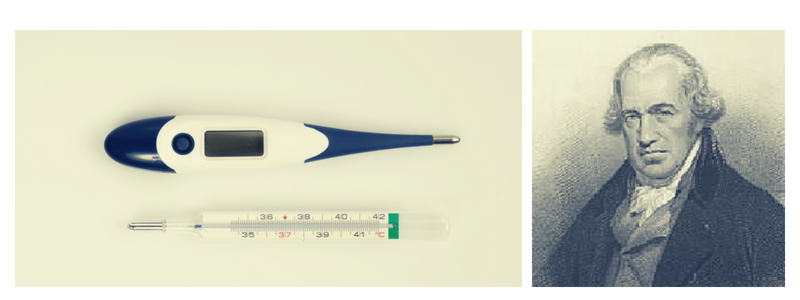
88. Breville sandwich maker
The earliest sandwich maker was possibly the Tostwitch, dating back to the early 1900s, but the patent for it was not filed until 1924 and granted a year later to Charles Champion. The sandwich maker everyone is familiar with, however, was invented in 1974 by John O’Brien for Breville. It was called the Snack’n’Sandwich Toaster and was capable of cutting the sandwich inside diagonally and sealing the sides.
89. Lithium batteries
Among all elements in the periodic table, lithium has one of the largest electrochemical properties while being one of the lightest at the same time. The first to propose the idea of the Lithium battery was M. Stanley Whittingham of Binghamton University in the 1970s; back then he was working for Exxon. The design was not practical enough for everyday use due to poor materials of choice: lithium metal and titanium sulfide. A breakthrough came in 1980 when John Goodenough and Koichi Mizushima invented a new type of battery in which the lithium could migrate from one electrode to another as a Li+ ion. The first commercial lithium-ion battery appeared in 1991 and was released by Sony and Asahi Kasei.
90. Apple iPod
It would be easy to dismiss iPod users as fanatical Apple fans for their willingness to pay a high price for a “simple” MP3 player. The truth is that the digital audio player is far from simple. The fact that it actually utilizes a hard drive for storage, comes equipped with Internet connectivity, and hides those features under a toy-like appearance was intriguing. While it wasn’t the first MP3 player, it surely is the most popular. One of the most welcome contributions of the iPod to the music industry is the way it allows users to choose the music they like on iTunes easily.
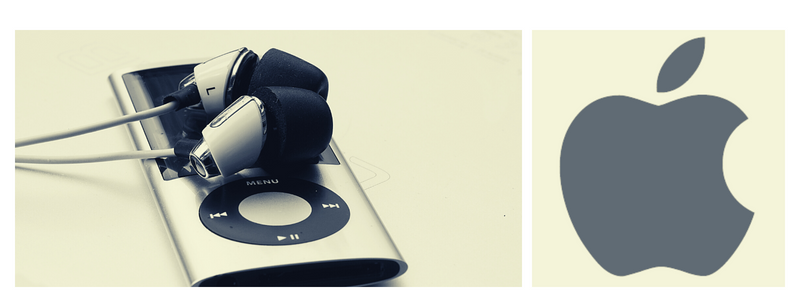
90. Plasma television
In July 1964, a team working at the University of Illinois consisting of Donald Bitzer, Gene Slottow, and Robert Willson invented the first flat-screen monitor. They wanted to address the limitations of the regular computer monitor, especially when used for graphics-related applications. Their flat screen emitted light using plasma technology, hence the plasma display. Unfortunately, many manufacturers were already working on the LCD screen, which ironically would delay the development of true flat screens for several decades. In 1996, Sony and Sharp took steps in a joint venture to produce an actual large flat screen. A year later, a 42-inch TV was made available for sale.
92. Palm pilot
The ubiquitous smartphone everyone uses today is the result of endless developments by many different companies. One of the brands that contributed to the smartphone is Palm Computing, who invented the Palm Pilot in 1996. By then, the company was still a division of U.S. Robotics. It was a true, fully functioning PDA with a stylus — the inventors (Jeff Hawkins, Donna Dubinsky, and Ed Colligan) started the development with the idea to create handwriting recognition software. The Palm Pilot did not feature flash memory but had a serial communication port.
93. Breathalyzer
The research to make a device that identified alcohol contents in the air began in 1874 when Francis E. Anstie found that small amounts of alcohol were excreted in the breath. It would take more than five decades for the world to see the first practical device to do exactly that. Rolla Neil Harger of the Indiana University School of Medicine took credit for the invention of Drunkometer in 1931. The device contained an acidified potassium permanganate solution, which would change color when exposed to alcohol-contaminated breath.

94. Pacemaker
Many people are contributed to the success of the pacemaker. One of the early models was invented by Albert Hyman in 1932; it was called the artificial pacemaker. He tried it on animals but never published human-testing results, partly because people thought he was using it to “revive the dead.” In 1958, Arne Larsson became the first patient to receive an implantable pacemaker designed by Rune Elmqvist. He received 26 pacemakers throughout his life. He died at the age of 86 in 2001, outliving the inventor of the pacemaker and the surgeon, Ake Senning.
95. Car radio
The first company to install a radio in a car was Chevrolet, but it was messy and expensive; the aftermarket add-on cost alone was $200 in the 1920s (or around $2,700 of 2017 money). In 1926, as custom radio installation became available, Paul Galvin fitted a radio to his Studebaker and started taking orders. He named his company Motorola, and it ended up being one of the biggest names in the technology industry.
96. OLED
Kodak was the first company to make and use an OLED-fitted device back in 1987. The screen was an invention of two employees, Steven Van Slyke and Ching W. Tang. One thing that made OLED popular was its ability to achieve higher contrast than LCD. In many marketing pitches, the OLED screen is said to have an infinite contrast ratio.
97. Apple iPhone
While it is not the first smartphone, it certainly is the most likable for many reasons. As far as the operating system is concerned, the biggest competitor is Android, and no one seems to know which one came first. What we do know is that the first iPhone had been on the market for almost a full year before the HTC Dream was released, the first true Android-powered device. Almost everything on the iPhone set the foundation for future smartphone models, from the shape, interface, and connectivity options.
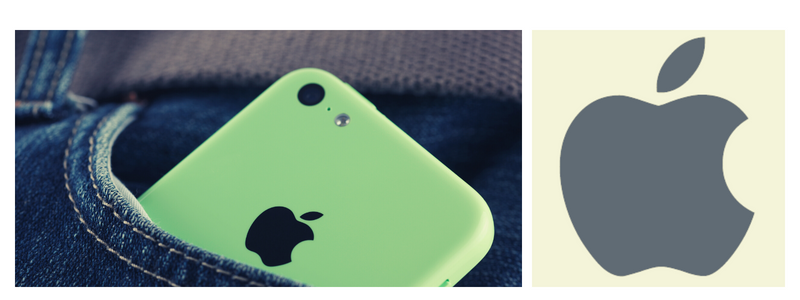
98. Texas instruments speak and spell
In 1978, there weren’t many handheld devices with visual displays. The Speak and Spell by Texas Instruments was one of those rare devices. It was also the first to utilize interchangeable cartridges for gaming purposes. It was advertised as an educational toy to teach children to speak and spell around 200 commonly misspelled words.
99. Multi-socket power plug
A strong reminder of the importance of patenting is the multi-socket power plug. Originally invented by Peter Talbot in 1972, the product is still making huge sales today. Talbot was working for Frank Bannigan of an Australia-based company called Kambrook. The company’s market share was eventually lost to competitors.
100. Autonomous vacuum cleaner
Powered vacuum cleaners with a suction mechanism were invented by Hubert Cecil Booth and David T. Kenney in 1901, but it was a stationary model. A portable home-grade vacuum cleaner was built by Walter Griffiths four years later. However, the appliance was still considered a luxury among the middle class until after the Second World War. Development and technologies surely made the appliance cheaper over time. One of the latest inventions in the vacuum-cleaning world market is the autonomous robotic model made by Electrolux Trilobite in 1997 and introduced in 2001.

101. Speech recognition machine
Speech recognition technology is now available for cheap, and it probably comes installed on your smartphone. The first one to utilize the technology was Bell Labs in 1952 when researchers for the company built single-speaker recognition by detecting speech sound spectrum frequency. Its capability was limited to recognizing 10 words or so. In 1960, Gunnar Fant built a speech-recognition model that proved useful. Around 30 years later, the Dragon Dictate became the first commercially successful speech-recognition device, selling at $9,000 per unit. And that’s a wrap. If you made it through this entire list, congrats!
Cad Crowd has freelance professionals that can bring your invention idea to life
If you have an idea that you think could one day be on this list and need a little help, Cad Crowd is here for you. Do you need help making a 3D model, or maybe some help figuring out how patents work? Well, find out how it works or get a free quote!
If you want to choose from multiple design concepts, you can do that with Cad Crowd’s design contests. Learn how you can launch a design contest.

Aorry but half of this is just anything that came around and was popular, I mean aerosol as number 11 really? They are not even remotely essential for society…for what it’s worth mine is GPS which I don’t even think is on this even though a few on the list are completely dependent on it…go figure..
open innovations
I think that these are great!
Hi I wonder when was the Windshield Wiper invented?
How about Windshield Wipers?
Xbox is definitly an excellent addition to the list.
Do you have legos in here?
Hi, I think there is a date error in your sewing machine entry you state, “Mechanical stitching machine dates back to several centuries ago, but a true portable sewing machine appeared for the first time in 1993 at Chicago World’s Fair.”
Hi Karen, the 1993 date refers to the date when portable sewing machines began mainstream production, rather than the larger/bulkier alternatives.
You have a spelling mistake on the section about bras. You say he instead of she.
What about the evolution of apple?